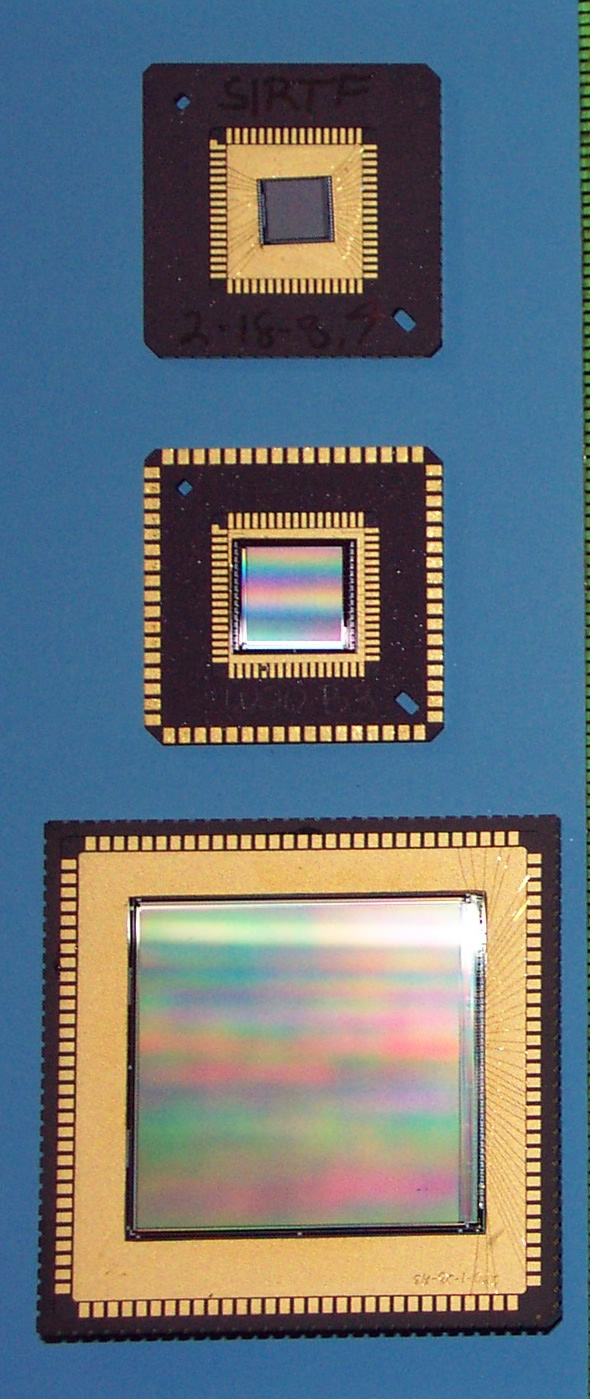

The lectures take place in room HL 414 in the Huygens building, on Fridays from 14:15 - 16:00 hr (unless otherwise noted - check schedule below).
Course level is 500. The course language is English.
Detectors are the crucial link between the astronomical target and the observer. As astronomers are aiming at fainter and fainter objects the quality and calibration of the detector systems have become increasingly important. The main goal of this course is to provide an overview of the various physical principles and techniques to detect electromagnetic radiation, from the UV to the sub-millimeter.
The course is split in two parts:
'Part A' (3 ECTS) is aimed at the observational astronomer and provides an overview of common detector technologies and their operation. Course topics are intrinsic and extrinsic photo-conductors, photodiodes and other junction-based detectors, detector arrays, bolometers, coherent receivers, and submillimeter- and millimeterwave heterodyne receivers. The course will not only provide the physical background of the various detector technologies but also cover practical aspects, which are of general interest to the observer, such as cosmetic quality and detector artifacts, linearity and dynamical range, spectral response and bandwidth, quantum efficiency and noise.
For students of Astronomy (Research) following DTL, part A is mandatory, part B is optional; for Instrumentation students, both parts are mandatory. Students who want to get credits for 'Part B' must have followed 'Part A' before.
'Part A' and 'Part B' each count ECTS (3+3).
The grade for 'Part A' is based to 80% on the written exam and to 20% on the mandatory homeworks. There are 8 sets of homeworks, which will be distributed after each lecture via the course website, and which shall be handed-in, on paper, at the start of the subsequent lecture (usually one week later). The exam is on Friday, 17 April 2020, 14:15 - 18:00 hr. It is a written, "closed book" exam. Pocket calculators are required at the exam.
In order to get the credits for 'Part B', one has to attend the lectures of 'Part B', as well as write a report, which is mainly a literature study on a topic which is related to one of the guest lectures. The report has to be written within six weeks and will not receive a numerical grade but receive an O/V/G "grade".
The course will be heavily based on the book Detection of Light - from the Ultraviolet to the Submillimeter, by George Rieke, 2nd Edition, 2003, Cambridge University Press, ISBN 0-521-01710-6, paperback ~90 €. It is recommended that students get their own copy of this book.
Recommended for further reading are:
|
# |
Date |
Mode |
Title |
Topics |
Homework |
|
1 |
7-Feb-20 |
f2f | Organization & Refresher of Solid State Physics | General: grading, exercises, book, nature of light, EM spectrum, technology, photographic plate, overview of detectors principles and types; solid state physics: atomic energy levels, crystal: bands, conductors and semi-condd., k-vector, Fermi energy |
Homework |
14-Feb-20 |
no lecture |
|
|||
|
2 |
21-Feb-20 |
f2f | Intrinsic Photoconductors & Noise | general principle, box diagram, conductivity, mobility, tau, gain, quantum efficiency and responsivity; intro noise: poisson & Gaussian & 1/f noise; detector noise: Johnson, kTC, 1/f, BLIP |
Homework |
3 |
28-Feb-20 |
f2f | Extrinsic Photoconductors | energy bands, doping, wavelength ranges, limitations, drawbacks and comparisons; BIB detectors, photodiodes, avalanche diodes |
Homework |
| 4 | 6-Mar-20 | f2f | IR Arrays & CCDs | IR arrays: principle, construction, readout electronics; CCDs: principle, back/front illuminated, thinned, readout, CTE, CT architectures, variants | Homework |
13-Mar-20 |
Covid-19 pause | ||||
20-Mar-20 |
Covid-19 pause | ||||
5 |
27-Mar-20 |
online | Operations and Artifacts | Readout schemes: SUR, Fowler, linearity & dynamic range, data rates; cryogenics |
Homework |
6 |
3-Apr-20 |
online | Operations / Bolometers | (Buffer slot -- will be filled) |
Homework |
| 10-Apr-20 | no lecture | Good Friday | |||
7 |
17-Apr-20 | online | Bolometers | Basic operation, time constants, superconducting, edged; comparison: responsivity, noise, NEP |
Homework |
| 8 | 24-Apr-20 | online | Heterodyne Detectors | general principle, IF, mixing, sidebands, bandwidth, components (HEB, SIS); performance: throughput, S/N, noise and antenna temperature, comparison coherent-incoherent detectors | Homework |
| 30-Apr-20 | online | oral exams | individual time slots still TBD | ||
| 1-May-20 | online | oral exams | individual time slots still TBD |
The guest lectures for 'Part B' run from 8 May through 19 June. There will be 6 lectures (on May 22nd, the university will be closed).
| Date | Speaker | Affiliation | Topic |
| 8-May-20 | Liz George | ESO | Development, characterization and operation of detectors for astronomy |
| 15-May-20 | Jochem Baselmans | SRON/TU Delft | Kinetic Inductance detectors for imaging and spectroscopy from optical to Terahertz astronomy |
| 22-May-20 | University closed | ||
| 29-May-20 | Akira Endo | TU Delft | On-chip spectrometers |
| 5-Jun-20 | Linda Höeglund | IRnova | QWIP detectors |
| 12-Jun-20 | Pourya Khosropanah | SRON | TES and applications |
| 19-Jun-20 | Alessandra Menicucci | TU Delft | Space radiation environment and its effect on detectors |